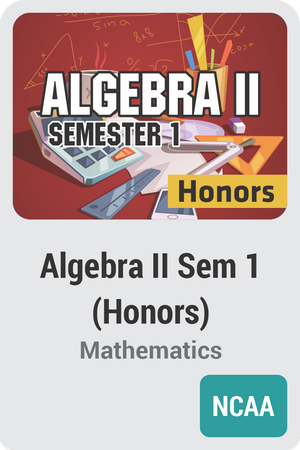
Course Overview:
Honors Algebra 2 is a rigorous math course designed to prepare a student for success in college level mathematics. It is recommended that a student have a strong mastery of Algebra 1 and Geometry concepts. This course emphasizes expanding critical thinking and problem-solving skills and uses technology as a tool for conceptual learning.
Semester 1 topics include working in the complex number system. The formal definition of a parabolic function is explored. Quadratic, polynomial, and rational functions are graphed and solved. The study of systems of linear equations is expanded to non-linear systems. The concept of matrices is introduced and used to solve systems of equations.
Required Material:
This course requires practice on GeoGebra and/or Desmos. These are both online free tools. In addition Graph paper may be needed for assignments.
Syllabus:
Section 1 - Algebra FoundationsThis section introduces the complex number system and the quotients of complex numbers. The concept of closure of sets is discussed. This section also reviews the definition of functions and transformations of functions. Sequences and series are introduced as an extension of the study of functions.
After this section the student will be able to:
- Perform mathematical operations with complex numbers.
- Understand the meaning of closure of sets of numbers.
- Define a function and determine the domain and range.
- Use function notation to represent a situation.
- Construct linear and exponential functions from given information.
- Write arithmetic and geometric functions to represent problems.
- Write geometric sequences in function form.
Lessons:
- Complex Number System
- Quotients of Complex Numbers
- Function Fundamentals
- Sequences and Series
Section 2 - Quadratic Functions
This section extends the study of quadratic functions introduced in Algebra 1. Conic sections are introduced and the formal definition of a parabolic function is explored. Graphing parent quadratic functions and their transformations are discussed. Many methods are used to find complex solutions to quadratic equations. Technology is used to find the curve of best fit for a set of data.
After this section the student will be able to:
- Recognize conic sections formed by slicing a double knapped cone.
- Graph a parabolic function from given information.
- Derive the equation of a parabola given the focus and directrix.
- Use many methods to find all complex solutions to a quadratic equation.
- Solve literal equations for the required variable.
- Rewrite a quadratic function in a variety of forms.
- Write the equation of a quadratic function from given information.
- Model real-world data with a curve of best fit.
Lessons:
- Writing Parabolic Equations
- Graphing Quadratic Functions and Parabolic Equations
- Solve Quadratic Equations
- The Quadratic Formula
- Modeling Data
- Activity: Modeling Data
Section 3 - Polynomial Functions
This section introduces the student to polynomial functions and identities. Factoring of polynomials is reviewed and extended to include cubic binomials. Pythagorean triples are introduced, and the Binomial Theorem is discussed. Zeros and end behavior are used to aid in graphing a function. The Remainder Theorem and Fundamental Theorem of Algebra are explored as ways to analyze the characteristics of a polynomial function.
After this section the student will be able to:
- Find complex factors of a quadratic function
- Factor cubic binomials
- Recognize Pythagorean Triples.
- Use the Binomial Theorem to expand binomials.
- Discuss the end behavior of function.
- Recognize the characteristics of an even or odd function.
- Find the zero of a polynomial function from a graph and by factoring.
- Know and apply the Factor and Remainder Theorem.
- Use long division and synthetic division to factor a polynomial.
- Know and use the Fundamental Theorem of Algebra.
Lessons:
- Operations with Polynomials
- Factoring Higher Order Polynomials
- Analyzing Polynomial Functions
- Factors and Zeros
Section 4 - Rational Functions
This section introduces students to rational functions. Graphs of rational functions are used to identify zeros, asymptotes, and end behavior. Mathematical operations are applied to rational expression. Closure of rational functions is discussed. Solving rational functions and identifying extraneous solutions is also presented. Real-world applications of rational functions are explored.
After this section the student will be able to:
- Graph rational functions, identifying asymptotes and end behavior.
- Apply mathematical operations to rational expressions.
- Discuss closer of the set of rational numbers.
- Solve rational equations, identifying extraneous solutions.
- Apply the concepts of rational functions to real-world situations.
Lessons:
- Graphing Rational Functions
- Adding and Subtracting Rational Expressions
- Multiplying and Dividing Rational Expressions
- Solving Rational Equations
Section 5 - Systems
This section focuses on systems of equations. A review of solving linear systems is discussed and extended to solving non-linear systems. Matrices are introduced and used as a method to solve systems of equations and inequalities. Matrices are also used to represent transformations on a plane and to find the area of geometric figures.
After this section the student will be able to:
- Solve linear systems of equations and inequalities using a variety of methods
- Solve non-linear systems using a variety of methods.
- Solve real-world problems using linear programming methods.
- Represent data in matrix form.
- Perform mathematical operations on matrices.
- Use matrices to represent geometric figures and their transformations on a plane.
- Use matrices to calculate area of geometric figures.
- Find the inverse of a matrix by hand and using technology.
- Use matrices to solve systems of equations.
Lessons:
- Systems of Equations
- Systems of Inequalities
- Introduction to Matrices
- Operations on Matrices
- Solving Systems Using Matrices


